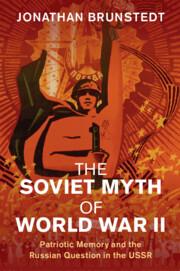Book contents
- The Soviet Myth of World War II
- Studies in the Social and Cultural History of Modern Warfare
- The Soviet Myth of World War II
- Copyright page
- Dedication
- Contents
- Figures
- Acknowledgments
- Abbreviations
- Additional material
- Introduction
- 1 Stalin’s Toast
- 2 Victory Days
- 3 Usable Pasts
- 4 Monumental Memory
- 5 Patriotic Wars
- Conclusion
- Bibliography
- Index
Conclusion
Published online by Cambridge University Press: 24 June 2021
- The Soviet Myth of World War II
- Studies in the Social and Cultural History of Modern Warfare
- The Soviet Myth of World War II
- Copyright page
- Dedication
- Contents
- Figures
- Acknowledgments
- Abbreviations
- Additional material
- Introduction
- 1 Stalin’s Toast
- 2 Victory Days
- 3 Usable Pasts
- 4 Monumental Memory
- 5 Patriotic Wars
- Conclusion
- Bibliography
- Index
Summary
In February 1987, members of a Russian ethnonationalist network calling itself Pamiat’ (Memory), after the title of Chivilikhin’s 1982 novel, rallied to the defense of a war memorial design by the sculptor Viacheslav Klykov. Klykov’s design – one of nearly 400 proposals exhibited in central Moscow as part of the renewed search for a “Victory” complex on Poklonnaia Hill – had incorporated a central monument that closely resembled a Russian Orthodox church. Although Klykov had conspicuously substituted a “Soviet” mother-motherland figure in place of a Christian cross, the Pamiat’ activists keeping vigil around the exhibition hall saw the motif for what it was: an attempt to anchor the Soviet victory in Russian historical continuity.
- Type
- Chapter
- Information
- The Soviet Myth of World War IIPatriotic Memory and the Russian Question in the USSR, pp. 257 - 266Publisher: Cambridge University PressPrint publication year: 2021

